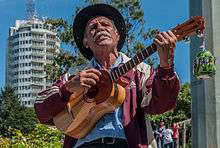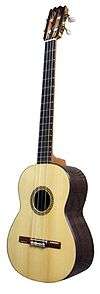Cuatro (Venezuela)
The cuatro of Venezuela has four single nylon strings, tuned (ad'f#'b). It is similar in shape and tuning to the ukulele, but their character and playing technique are vastly different. It is tuned in a similar fashion to the traditional D tuning of the ukulele, but the A and B are an octave lower. Consequently, the same fingering can be used to shape the chords, but it produces a different inversion of each chord.[1] A cuatro player is called a cuatrista.
 Venezuelan Cuatro. | |
| String instrument | |
|---|---|
| Other names | Venezuelan Cuatro |
| Classification | String instrument |
| Hornbostel–Sachs classification | (Composite chordophone) |
| Developed | Venezuela |
| Related instruments | |
| Ukulele, Cavaquinho, Guitar, Bandola (Llanera). | |

History

Its 15th-Century ancestor was the Portuguese Cavaquinho. The predecessor of the Venezuelan cuatro is the four-string Spanish guitar which disappeared in the 16th century after a short period of surging popularity. In the 1950s, Fredy Reyna documented the evolution of the renaissance guitar into the current Venezuelan Cuatro, and reinvented the cuatro as a solo instrument, equally capable of rendering traditional Venezuelan music as well as Renaissance pieces. The popularity of the instrument in Venezuela and elsewhere may be due to its apparent simplicity, having only four strings, as well as its compact size.
The design and quality of its construction may vary widely, from rustic, inexpensive instruments, to the custom-built Concert Cuatro, comparable to the finest Classical Guitars. The cuatro is often said to be the Caribbean version of the ukulele (although the cuatro was invented three centuries earlier), having a similar sound, looks, and tuning; and being used in Venezuela, Trinidad, and throughout various other Caribbean spots.
Playing
The cuatro is particularly designed for strumming: the fingerboard finishes flush with the top of the instrument, and the upper half of the sound board is often completely covered by a scratch plate made from hardwood.
Most of Venezuelan folkloric music relies on the cuatro as its rhythmic and harmonic base. It is used in most genres of the different regions of Venezuela, such as Joropo in the Llanos, Gaita in Zulia, Galerón in the Oriente or calypso in Trinidad.
A recent evolution in playing technique has made the cuatro a versatile instrument capable of handling, on its own, solo parts including both melody and harmony. The technical and musical knowledge and expertise required to be able to play the instrument in this way is astounding. The results have made Venezuelan traditional music leap to a whole new level of complexity, many times encompassing the utilization of jazz harmonic structures and melodic phrasing to enrich many traditional tunes. The cuatro is used in waltz, joropo, parang, calypso, and soca.
Tuning
There are several tunings possible on the cuatro, but they are mostly transpositions of the main tuning (below), which may depend on the accompanied singer's range or the tone of the harp the cuatro is playing with. The strings are tuned from top to bottom (using the numbers 1, 2, 3, and 4), to these intervals:
- strings 1 and 2 – perfect fourth
- strings 2 and 3 – major third
- strings 1 and 4 – major second
The most popular tuning for the cuatro is A D F♯ B, with the B string tuned to a major second interval from the A string (instead of the more "guitar-like" perfect fourth from the F♯).
The practice of not tuning the strings in order, from low to high, is known as "reentrant tuning". Reentrant tuning helps to achieve similar sounds between the downstroke and the upstroke on strummed instruments. The ukulele and 5-string banjo also use reentrant tunings, although with the first and last strings the higher pitched ones, unlike the low A and B of the cuatro. In fact, early ukuleles were tuned to a D f♯ b,[2] with the D the lowest note. (Currently ukuleles are usually tuned one note lower, g C e a,[2] and some use a non-reentrant low G fourth string.) Reentrant tuning is a very old practice; possibly it was originally a way to prolong the life of gut strings, which were used until the early 20th century.
In 1948, Fredy Reyna altered the way the cuatro is strung and broke with reentrant tuning. His cuatro, called "solista" (soloist), was tuned in strict ascending pitch order. After trying many tunings, Reyna settled on E A C♯ F♯ as the one he used the most. In doing this, he (inadvertently at the time) arrived at the stringing and tuning of the Renaissance guitar. His work has been meticulously documented by Reyna himself, but it has not been widely adopted.
A popular way to remember the tuning of the cuatro among Venezuelan cuatro players is to play each string individually from top to bottom, while singing the words Cam-bur pin-tón in the same expected notes of the four cuatro strings. (Cambur Pintón means Ripe Banana in Venezuela. The phrase is used mainly because its four syllables are long and because of its easy-to-remember nature). A variation is Hi-pó-cri-ta, playing the strings from bottom to top.
The "Venezuelan" cuatro in other countries
The cuatro is an important part of "música llanera", belonging to the Venezuelan area known as "El Llano". As such, el cuatro is widely used in eastern Colombia. El cuatro is also used in Trinidad and Tobago to accompany musical bands at Christmas time singing about the birth of Christ. This type of music is called parang, from the word "parranda," meaning "to make merry." Parang music mixed with a calypso flavor has found itself deeply rooted in the culture of the people of this Caribbean country. The language used in the songs is mostly Spanish but Patois and English are used as well. This richly adds to the rhythmic sounds of this versatile instrument. The cuatro, under the name cuarta, is also very popular on the Dutch Lesser Antilles, Aruba, Curaçao and Bonaire, where it is used for different types of music, including the traditional tumba, waltz, danza, polka, calypso, bolero, march and several others.
Some famous Venezuelan cuatro players
- Roy Jelinek: Took the Cuatro to a whole new level of complexity and recognition throughout the world by developing his own style of playing, producing a unique effect which gives the impression of a singing instrument." "A Cuatro for the World." Composer of "Para Maria," "Para Alejandra," " Canción de Roy," "Flor De Mayo," "El Morrocoy," "Road to New Orleans," "Caraqueñísima," "Alma Japonesa," "El Carajito."
- Simón Díaz – Venezuelan singer and cuatro player. While not a cuatro virtuoso "Uncle Simón" is the face of the llanero folksinger. His is the composer of "Caballo Viejo" and "El Becerrito"
- Hernán Gamboa – Founding member of Serenata Guayanesa. Left in the 1980s to pursue a solo career. Invented a method to play the cuatro called "rasgapunteo" (Spanish)
- Fredy Reyna – took the playing capabilities of the instrument to new heights, and created a method of teaching the cuatro. Famous soloist.
- Cheo Hurtado of Ensamble Gurrufío
- Leonardo Lozano Escalante: Venezuelan master of soloist cuatro "cuatro solista" or concert cuatro, "cuatro de concierto". Lozano has taken this instrument to the well-deserved level of a soloist instrument composing, performing and recording outstanding works for cuatro and piano, cuatro and chamber orchestra, cuatro and symphonic orchestra.
- Jorge Polanco
- Jorge Glem
- Hector Molina
- Edward Ramirez
- Luis Pino
- Daniel Requena
- Nil Lara
- Juan Carlos Salazar – Venezuelan singer, guitar and cuatro player.
- Henry Linarez – World renowned cuatro player from Barquisimeto that developed a fusion between Afro-American Jazz and Venezuelan Folkloric Music.
- Rafael "Pollo" Brito
- Steve Knightley and Phil Beer – Form the great British Folk duo Show Of Hands. Both can play the Cuatro with Steve writing and arranging classic British folk songs on the Cuatro.
- Dominic Thompson Trinidad and Tobago
External links
References
- "Instrumentos Musicales de Venezuela: Cuatro". Diccionario Multimedia de Historia de Venezuela. Fundación Polar.
- Fredy Reyna: Alfa Beta Cuatro - Monte Avila Editores 1994
- Alejandro Bruzual: Fredy Reyna - Ensayo biográfico - Alter Libris 1999
- "The Stringed Instrument Database". Archived from the original on 2011-12-18. Retrieved 2010-08-02.
- The smaller, lower case letters represent notes pitched one octave higher than the larger, lowercase letters; see Helmholtz pitch notation.